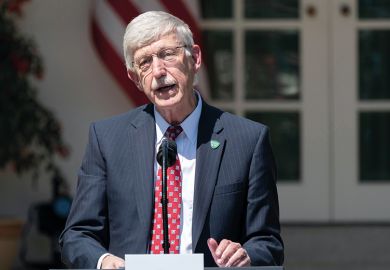A Biden administration attempt to create a new advanced research unit of the National Institutes of Health is hitting some pushback from both scientists and lawmakers who question the overall trade-off.
The NIH, with an annual budget of $42 billion (£30 billion), is already the top supplier of basic research money to US universities. President Joe Biden is seeking $51 billion this coming year, with most of the increase – $6.5 billion – for what he sees as a medical version of Darpa, the Defense Advanced Research Projects Agency.
The new NIH division, to be called Arpa-H, “will complement NIH’s existing research portfolio, providing an agile and flexible arm to advance biomedical science quickly and robustly”, the administration said in its fiscal year 2022 budget request to Congress.
As with a parallel proposal to sharply increase funding for the National Science Foundation, the idea is finding a bipartisan mix of support in Congress, along with concern that large and rapid shifts in resources might overlook more urgent policy needs and undermine the long-successful formula of government funding of basic science.
“It is critical that we strike a balance between this new approach and investments in basic research and fundamental discovery at NIH,” said Rosa DeLauro, a Democrat and chairwoman of a House of Representatives panel on education and health spending, in a review of the Arpa-H plan.
Darpa, part of the US Department of Defense, has gained worldwide renown for its model of fostering innovation by allowing its managerial teams to put forth deeply ambitious ideas and then supply the necessary funding to researchers and developers as long as progress is made.
That would be a major departure, at least within the Arpa-H portfolio, from the NIH’s general system of allocating funding for several years at a time on the basis of careful peer-review assessments by fellow scientists.
Mr Biden has shown a personal enthusiasm for the move. He has pushed for aggressive cancer research since the death in 2015 of his son Beau, and he spoke during the 2020 presidential campaign of bringing the Darpa model to healthcare.
Many Democrats and Republicans in Congress also appear eager to spend more money on science, driven in many instances by fears that the US is falling behind other nations in innovation-driven economic development.
But there are lawmakers, as well as some in academic science, who are wary of trying to spend too much too fast. Congressional leaders already are scaling back a proposal by some leading members of both parties to roughly triple the $8.5 billion budget of the National Science Foundation, also with a primary emphasis on improving the translation of lab discoveries into products.
In arguing for Arpa-H, the director of the NIH, Francis Collins, who served through the Obama and Trump administrations, suggested that it could mean breakthroughs in such transformative areas as the creation of simple blood tests to detect cancer, and patches with tiny needles that contain vaccines and can be delivered by mail.
“With standard approaches, well, they might happen in a decade or two,” he told Congress. “With Arpa-H, we believe it could take half that time.”
Register to continue
Why register?
- Registration is free and only takes a moment
- Once registered, you can read 3 articles a month
- Sign up for our newsletter
Subscribe
Or subscribe for unlimited access to:
- Unlimited access to news, views, insights & reviews
- Digital editions
- Digital access to THE’s university and college rankings analysis
Already registered or a current subscriber?




